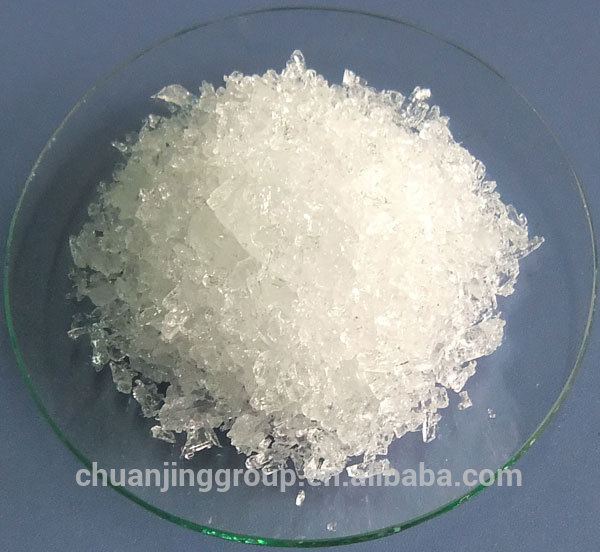 | ||
Terbium europium yttrium oxide chloride erbium cerium nitrate neodymium acetate cerium praseodymium
Cerium nitrate refers to a family of nitrates of cerium in the three or four oxidation state. Often these compounds contain water, hydroxide, or hydronium ions in addition to cerium and nitrate. Double nitrates of cerium also exist.
Contents
- Terbium europium yttrium oxide chloride erbium cerium nitrate neodymium acetate cerium praseodymium
- CeriumIII nitrates
- CeriumIV nitrates
- Ammonium and alkali metal cerium nitrates
- Divalent double nitrates
- Other Cerous double nitrates
- Ceric double nitrates
- Divalent metals
- Other compounds
- References
Cerium(III) nitrates
Cerium(IV) nitrates
Ceric nitrate is quite soluble in non polar solvents such as ethyl ether. Ether will extract the cerium nitrate from 5N nitric acid. In nitric acid nitrato ceric acid (H2[Ce(NO3)6] and H[Ce(NO3)5.H2O]) is present. Owing to its solubility of this nitrate in non-polar solvents allows the separation of cerium from other rare earths.
Ammonium and alkali metal cerium nitrates
Divalent double nitrates
Cerous magnesium nitrate is the first discovered member of a divalent series CeM(II)(NO3)5. This has an extremely low Kapitza resistance to liquid 3He. At the time of discovery it value was only 1% of the previous record holder. Low thermal resistance is important at temperatures below 1K, because there is not much temperature difference to cause a large heat flow rate, and cooling can take an excessive time if there are barriers to heat transfer.
Other Cerous double nitrates
Cerous sodium nitrate monohydrate, Na2Ce(NO3)5.H2O has density 2.641 g/cm3. It can be made by boiling the stoichiomentric mixture of cerous nitrate, and sodium nitrate in nitric acid, and then evaporating at 40 °C. The crystals are clear rod shaped monoclinic with space group P2/C. Crystal cell sizes are a=21.387 b=7.9328 c=15.184 β=90.657 V=2576 formulas per cell Z=8. The way the components are arranged in the crystal is that there are six nitrates around each cerium atom, however to get to the average of five per cerium, two nitrate groups on each, link the atoms into a chain along the an axis.
There are anhydrous double nitrates such as Ce2Rb3(NO3)9 and Ce2K3(NO3)9. The potassium salt, Ce2K3(NO3)9 can be made by using the water solution of potassium nitrate and cerous nitrate in 3:2 molar ratio, evaporated at 40 °C. The crystals are colourless cubic from space group P4132. Its formula weight is 955.6. Three formulas exist in each unit cell which at 20 °C, has a volume of 2514.1 Å3 and cell side of a=13.597 Å. The density is 2.525 g/cm. In this compound each cerium atoms is surrounded by twelve oxygen atoms from six nitrate groups. Three of the nitrates form a bridge in each of three dimensions. These bridges form three spirals each at 90° to each other along the crystal axes.
A related series with ratio 1.5 of the monovalent ion to cerium includes 2Ce(NO3)3.3(NH4)NO3.12H2O
A mixed caesium, sodium cerium triple nitrate Cs2NaCe(NO3)6 crystallizes in the cubic system. The unit cell size is 1.1196 nm with volume of 1.4034 nm3 and four molecules per cell.
Ceric double nitrates
The alkali metals form orange-red monoclinic crystals as a double salt with ceric nitrate: M
2[Ce(NO
3)
6] with M=K, Rb, Cs, or [NH4].
3)
6]2−
which has cerium in the +4 oxidation state. It is used as a reagent in oxidimetry.
2[Ce(NO
3)
6] has two different crystal forms, hexagonal and monoclinic. Slow evaporation and crystallization results in the monoclinic form. But fast crystallization results in a mixture of the two shapes. Both of these forms have six nitrate groups connected via two oxygens each to the cerium [Ce(NO
3)
6]2−
. The substance is made by dissolving ceric hydroxide in nitric acid with the appropriate stoichiometric amount of potassium nitrate. In the hexagonal form the cerium atoms are arranged along a threefold axis. In hexagonal form the potassium ions are surrounded by nine oxygen atoms. These crystals are orange hexagonal shaped plates. Crystal cells contain three molecules, with a volume of 1063.1Å3 and dimensions of a=13.5737Å c=6.6624Å with a density of 2.767 g/cm3.
In the monoclinic form of K
2[Ce(NO
3)
6], the cerium atoms are in a body centred arrangement, with potassium surrounded by ten oxygen atoms. The density is 2.798 with a cell that contains two molecules with volume 700.9Å3 and dimensions a = 12.707Å b = 6.6858Å c = 8.253Å and β = 91.55°.
Ceric potassium nitrate also has a hydrate with 1.5 mols of water.
2[Ce(NO
3)
6] is reddish yellow.
2[Ce(NO
3)
6] is very insoluble in nitric acid and is bright yellow.
Divalent metals
3)
6.8H
2O]
3)
6.8H
2O]
3)
6.8H
2O]
3)
6.8H
2O]
3)
6.8H
2O]
